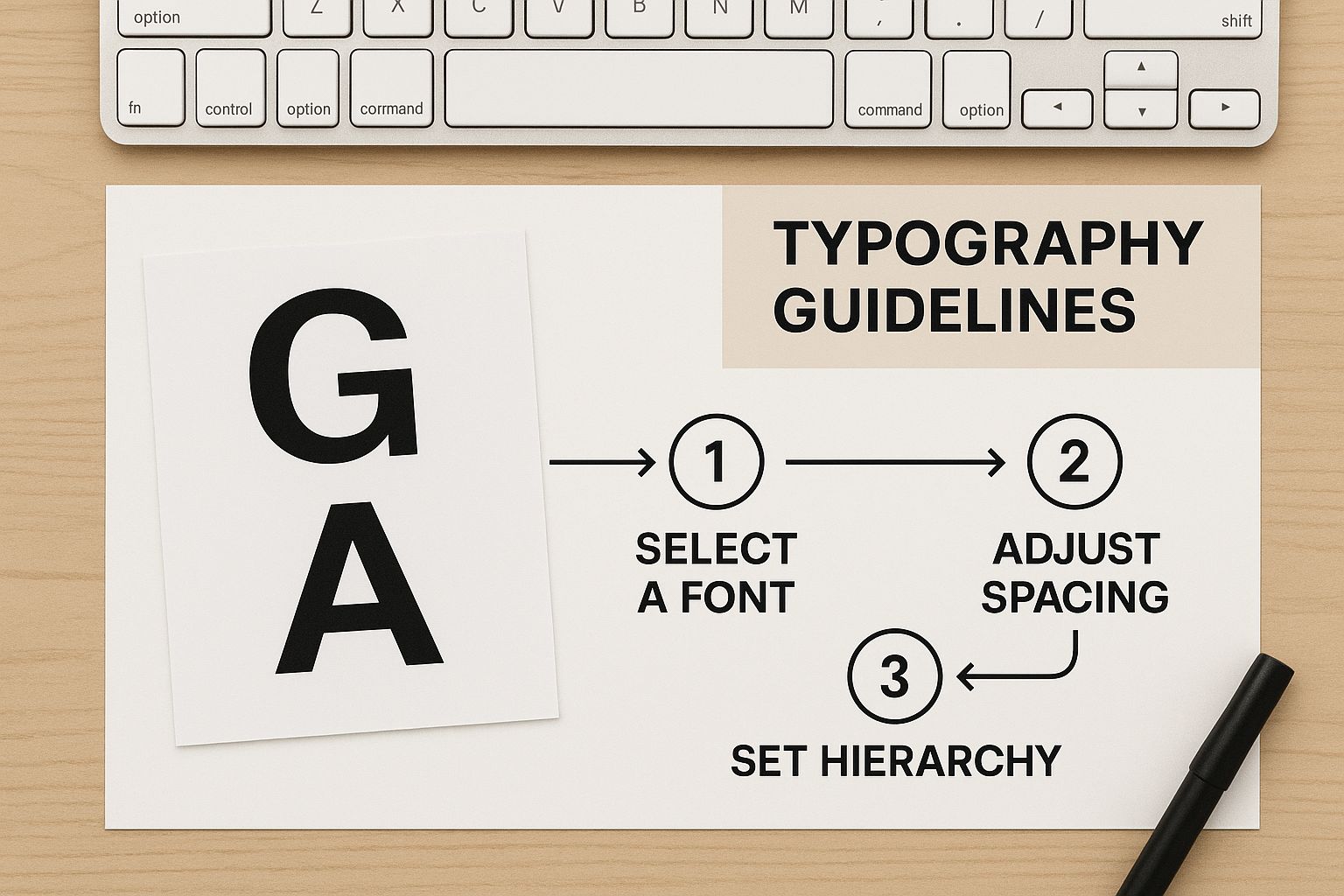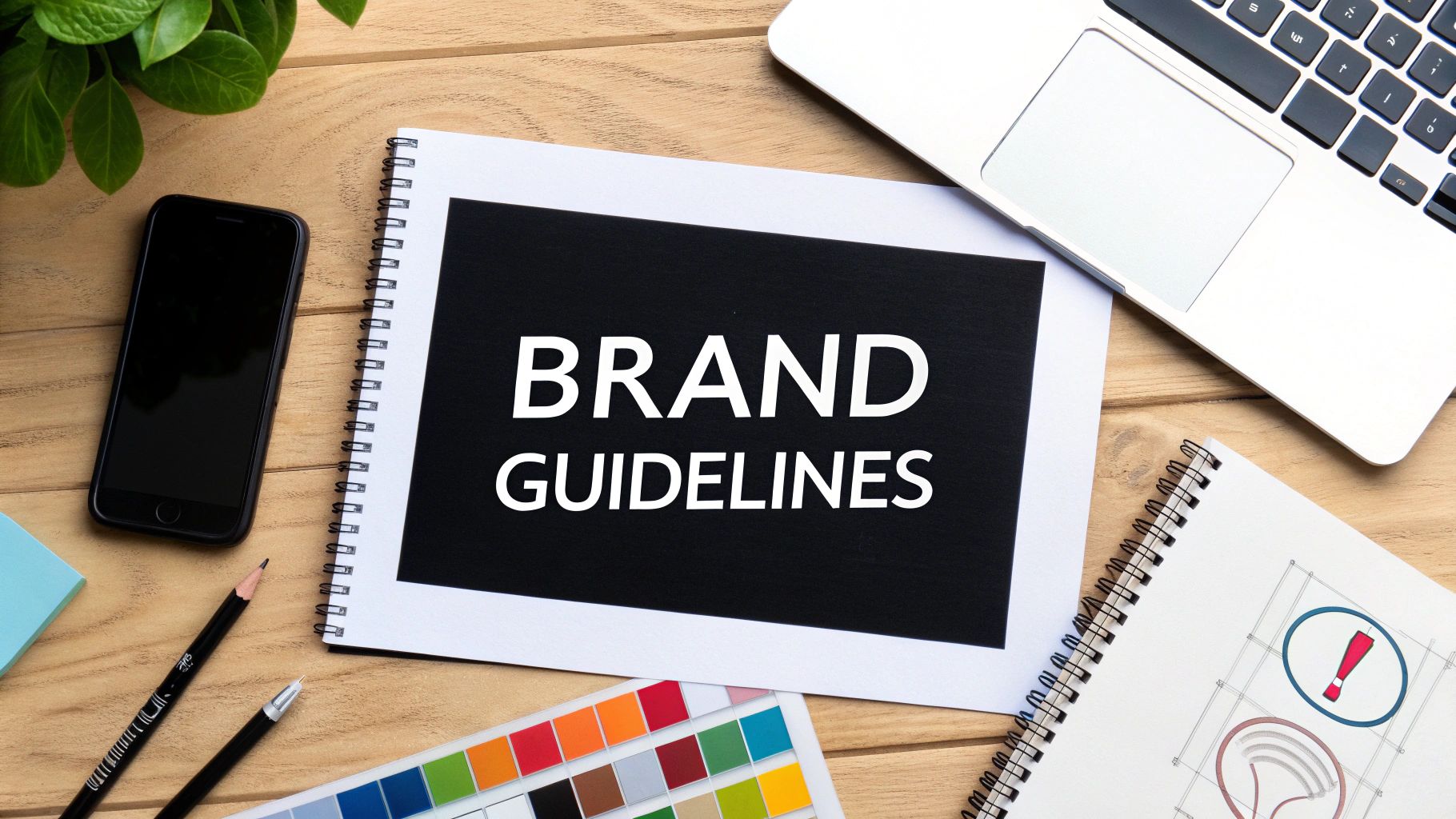Your social media presence is often the first, and most frequent, interaction people have with your brand. Think of your social media guidelines as the official playbook that ensures every single one of those interactions is consistent, authentic, and unmistakably you.
This isn't just about rules; it's a strategic framework that empowers your team to present your brand perfectly every time.
Why Clear Social Media Guidelines Are a Must-Have
Imagine your brand as a person having thousands of conversations online at once. Without a clear identity, it's like sending out a dozen different people to represent you—each with their own personality, tone of voice, and style. The result? Confusion. It dilutes your message and makes your brand completely forgettable in an endlessly scrolling feed.
Well-defined social media brand guidelines fix this. They transform a chaotic collection of posts into a cohesive and powerful marketing force. This document isn't meant to stifle creativity. On the contrary, it gives your team—from the social media manager to the customer service rep—the confidence to communicate with one, unified voice.
Building Trust Through Consistency
Consistency is the bedrock of trust. When your audience sees the same personality, visuals, and voice across Facebook, Instagram, and TikTok, they start to feel like they actually know you. This familiarity is what builds credibility.
The link between trust and sales is incredibly strong. In fact, a staggering 81% of consumers say they need to trust a brand before they even think about buying from it. On top of that, simple brand recognition can make a real difference, with studies showing that 15.5% of consumers are more likely to buy from a brand they can easily identify.
A brand without guidelines is like a ship without a rudder. It might be moving, but it's certainly not heading toward its destination. These rules provide the direction you need to navigate the choppy waters of social media and actually get somewhere.
What Goes Into Your Social Media Playbook?
Effective guidelines go way beyond just a logo and a few approved colors. They should provide a complete roadmap for your team to follow every day. While these elements are part of a larger brand strategy, your social-specific guide needs to be focused and actionable. For a look at the bigger picture, you can see our guide on how to create brand guidelines and how this all fits together.
To get started, here’s a look at the essential components every social media guide needs.
Key Elements for Your Social Media Guidelines
This table gives you a snapshot of the core components your social media brand guidelines must include to be truly effective. Think of it as your checklist for creating a document that leaves no room for confusion.
By putting these rules down on paper, you eliminate the guesswork. You’re not just managing a social media account; you’re building a team of confident brand ambassadors who know exactly how to represent you well.
Finding Your Brand’s True Voice and Tone

Let's get one thing straight: your brand's voice is its personality. It’s the consistent character that shines through everything you publish. Just slapping on generic labels like "friendly" or "professional" is a ticket to being forgotten. An authentic voice makes you feel human, and that’s how you build a real connection.
Think of it like this: your voice is your core personality, but your tone is your mood. Your personality doesn't change day-to-day, but your mood definitely does. A powerful trick I've used for years is to describe the brand as if it were a person. What are its defining character traits?
For instance, instead of just "friendly," you could land on something like: "The witty, insightful mentor who’s always encouraging and never condescending." See? That gives your team something tangible to work with.
From Personality to Practice
Okay, so you’ve defined your brand’s personality. Now what? You need a practical way to use it across different situations without sounding like a broken record. This is where a voice spectrum becomes your secret weapon in your social media guidelines. It’s a simple chart that helps your team adjust their tone while staying true to the core voice.
Think of it as a set of sliders for each personality trait you’ve defined.
- For "Witty": The slider could go from Playful Banter on one end (perfect for fun, celebratory posts) to Dry Humor on the other (for when you need a lighter touch on a more serious topic).
- For "Insightful": This might range from Authoritative Guide (when you're dropping knowledge bombs) to Supportive Advisor (when helping a customer sort out an issue).
This method keeps you from sounding tone-deaf. You wouldn’t use the same tone to celebrate a huge company win as you would to handle a customer complaint, right? But both responses should still feel like they came from the same brand.
Defining your voice isn’t about handcuffing your team with rigid rules. It’s about creating a character so vivid that anyone can step into its shoes and speak with confidence.
Seeing Voice and Tone in the Wild
Just look at how some of the big players do it. Duolingo's voice is consistently quirky and a little bit unhinged—a personality they commit to everywhere, even in push notifications. On the flip side, Patagonia’s voice is passionate and purpose-driven, tying every post back to their core mission.
To get your own creative juices flowing, it's worth checking out some unforgettable brand voice examples from companies that are nailing it.
A super practical tool to include in your own guidelines is a simple "This, Not That" chart. It gives your team crystal-clear, side-by-side examples of what your brand sounds like—and what it doesn’t.
This kind of framework turns abstract ideas into concrete actions. It gives everyone on your team the confidence to communicate with a voice that’s not just consistent, but genuinely connects.
Nailing Your Visual Identity on Social Media
Think of your visual identity on social media as your brand's digital handshake. It’s the very first impression you make, long before anyone reads a single word you've written. This is your secret weapon for building instant brand recognition. It’s about more than just slapping your logo on everything; it’s about crafting a unified look that feels deliberate and professional, no matter where people find you.
When your visual system is locked in, someone can see your post on Instagram, a video on TikTok, or a professional update on LinkedIn and know it’s you in a split second. That kind of consistency builds trust and makes your brand feel credible and established. The rules you set here are the bedrock of your entire social media presence.
Logo Usage and Placement
Your logo is your brand's signature. If you don't set clear rules for it, you risk it being stretched, squashed, or just plain misused, which can make even the most premium brand look amateur.
Your guidelines should get super specific about a few key things:
- Clear Space: This is the "breathing room" around your logo. Define the minimum amount of empty space that must always surround it to keep it from looking cluttered.
- Minimum Size: Set the absolute smallest your logo can appear, measured in pixels. You'll need different minimums for web and mobile to make sure it's always readable.
- Approved Versions: Clearly show which versions of your logo are good to go. This includes the full-color version, a one-color (monochrome) option, and maybe just your icon. Show which one to use on light vs. dark backgrounds.
Defining Your Color and Font System
Color is a powerhouse for brand recognition. You need to be crystal clear here to maintain consistency, especially since colors can look slightly different from screen to screen.
Your brand's visual elements aren't just for decoration; they're a language. A consistent visual language speaks volumes about your reliability and professionalism, making your audience feel more secure engaging with you.
Start by defining your primary and secondary color palettes. Don't just show the colors—list their HEX codes (like #1A2B3C) to eliminate any guesswork for your team.
Next up is typography. This dictates the feel of any text on your images or in your videos. Pick one or two core fonts—a primary one for bold headlines and a secondary one for body copy—and commit to them. Specifying the exact fonts and weights (e.g., "Helvetica Neue Bold" for titles, "Roboto Regular" for text) ensures every single graphic feels like it belongs to the same family. If you're still on the fence, our guide on choosing colors for your brand can help you think strategically.
Setting an Image and Video Style
Finally, you need to decide on the overall vibe of your photos and videos. Are you going for bright, airy, and optimistic? Or is your style more dark and moody? Do you prefer candid, in-the-moment shots, or is everything professionally staged? Make sure to specify any approved photo filters or editing presets to keep the look consistent.
If your company is thinking about a brand refresh, it helps to see what has worked for others. You can explore some iconic rebranding examples to see how powerful visual changes can be. Creating a set of pre-made templates for different platforms—like for Instagram Stories or LinkedIn banners—is a fantastic way to make it incredibly easy for your team to create content that’s always on-brand.
Developing Platform-Specific Content Strategies
Let's get one thing straight: a one-size-fits-all social media strategy is a surefire way to get ignored. What works on LinkedIn will absolutely bomb on TikTok. This is where your social media brand guidelines really prove their worth—not as a rigid rulebook, but as a flexible framework that helps you adapt. The goal is to let your core brand identity feel native to each platform.
This isn't just a "nice-to-have" anymore. We're talking about an estimated 5.42 billion social media users worldwide, with the average person hopping between nearly seven different networks a month. They expect a different vibe on each one, and your brand has to deliver. If you're curious, you can find more insights on social media user habits and what that means for businesses.
This infographic shows exactly what I mean, breaking down how a core element like typography can be adapted across different platforms while still feeling like your brand.

It’s a great visual reminder that even something as fundamental as a font choice has to be made with the platform's layout and user expectations in mind.
Tailoring Your Strategy for Key Platforms
So, how do you actually do this? Let’s break down how to approach a few major platforms with very different crowds and content rules. Your guidelines should basically include a mini-playbook for each one so your team knows exactly how to show up.
LinkedIn: The Professional HubThis is the boardroom of social media.
- Who you're talking to: Professionals, B2B decision-makers, and industry leaders.
- What to post: Think thought leadership, deep industry insights, company news, and career-focused content. This is the place for your well-researched articles, detailed case studies, and professional videos.
- How to sound: Keep it professional and authoritative, but don't be a robot. It should still be approachable. If your brand is witty, that might translate to some dry humor here instead of playful banter.
- Hashtag approach: Less is more. Use 3-5 hyper-relevant, niche hashtags like
#B2BMarketing,#SaaS, or#LeadershipDevelopmentto connect with a specific professional audience.
Instagram: The Visual Storytelling CanvasThis is where your brand’s personality gets to shine.
- Who you're talking to: A broad audience that skews younger, primarily Millennials and Gen Z.
- What to post: High-quality visuals are everything. Focus your energy on creating killer Reels, engaging carousels, and a feed that’s just plain nice to look at. Behind-the-scenes glimpses, user-generated content, and tutorials do incredibly well here.
- How to sound: Loosen up! Be more informal and conversational. Let your brand’s unique voice come through in your captions, comments, and Stories.
- Hashtag approach: Go for a mix. Using 10-15 hashtags—a combination of broad, niche, and branded ones—is a good strategy to maximize your reach.
Your goal isn't to become a different brand on each platform. It's to be the best version of your brand for that specific audience. Think of it like speaking the same language but just adjusting your dialect.
Adapting for Short-Form Video Dominance
And then there's the world of TikTok and Instagram Reels, which have their own culture entirely. That slick corporate video you made for LinkedIn? It will stick out like a sore thumb here.
Your guidelines need to address this head-on:
- Content Format: The emphasis is on short, snappy, and trend-aware video. Authenticity almost always beats high production value.
- Frequency: These platforms reward consistency. Outline a realistic schedule for your team, maybe aiming for 3-5 posts per week.
- Tone: Encourage a more playful, experimental, and direct-to-camera style. Jumping on relevant trends is one of the fastest ways to show you "get it."
By defining these platform-specific approaches, you're giving your team the tools to create content that doesn't just look on-brand but feels right for the environment. That’s how you get people to stop scrolling and actually connect with what you have to say.
Setting Your Rules for Community Engagement

Your brand’s personality and visuals get you noticed, but community engagement is where the real relationships are built. Every like, comment, and direct message is a chance to show your audience you’re listening. If you don't have clear rules of engagement, your team is flying blind, and that leads to inconsistent replies and missed opportunities.
Think of this part of your brand guide as a playbook for every interaction. It gives your team the confidence to act as true brand ambassadors, turning simple conversations into loyalty-building moments. It's all about being prepared, responsive, and, above all, consistently you.
Establishing Your Response Protocols
First things first: you need to define how and when your team should jump into the conversation. Simply telling them to "respond to comments" is far too vague. You need to get into the details to deliver a consistently great experience.
- Set a Response Time: Be specific. Create a clear service level agreement (SLA), like committing to answer all DMs within 2 hours and all public comments within 12 hours. This manages expectations and shows you care.
- Define Simple Acknowledgments: What about the simple "Love this!" comments? Decide on a standard action. It could be as easy as liking the comment or replying with an approved brand emoji. This prevents those positive interactions from going completely ignored.
- Connect to Your Tone of Voice: Circle back to your brand's personality. If your brand is "witty," maybe playful GIFs are perfect for replies. If you're more "authoritative," you'll want to stick to clear, informative text.
Let's be real—these interactions are a huge deal. With social media ad spend projected to hit $276.7 billion and U.S. social commerce sales rocketing past $90 billion, every comment is a potential sales touchpoint. Clear rules are essential for turning this massive audience into customers. You can discover more insights on the growth of social commerce to see just how big the opportunity is.
A great response protocol doesn't just solve problems—it makes your followers feel seen and valued. This is how you turn a casual follower into a true brand advocate.
Handling Negative Feedback and Knowing When to Escalate
Not every comment will be a glowing review, and that’s perfectly fine. How you handle criticism says more about your brand than a thousand positive comments ever could. Your guidelines need a crystal-clear process for managing complaints and dealing with toxic behavior.
Draw up a simple escalation plan. For instance, a complaint about a late delivery might start with a public apology and a request to switch to DMs. If two DM exchanges don't solve it, the next step could be to escalate it to a senior support manager.
Your guidelines also need a zero-tolerance policy for hate speech, spam, and abuse. Define precisely what gets hidden or deleted, and what behavior justifies blocking a user. Protect your community and your team.
Nurturing Proactive and Positive Engagement
Community management isn't just about firefighting. It’s also about proactively stoking the fire of positive conversations. A solid strategy includes celebrating the good stuff.
Decide on your process for sharing user-generated content (UGC). This should spell out exactly how to ask for permission to repost and how to credit the original creator in the caption and tags. Featuring your customers is one of the most powerful forms of social proof you have. For a complete guide on this and other essentials, our top brand guidelines checklist can help ensure you've covered all your bases.
Common Questions About Social Media Guidelines
https://www.youtube.com/embed/oMzdnVdoWqE
As you start pulling together your own social media guidelines, you'll inevitably run into a few common questions. I've seen these trip up teams time and time again. Getting the answers right from the start is the difference between a guide that sits on a virtual shelf and one that actually gets used every day.
Let's walk through some of the most frequent ones.
How Often Should We Update Our Guidelines?
Think of your social media guidelines as a living document, not something you carve into stone. The social world just moves way too fast for a "set it and forget it" approach.
I always recommend a formal review at least once a year. This is your chance to take a step back and see if your rules still make sense with your current marketing goals and where your brand is heading.
But honestly, you need to be ready to make changes on the fly. Good triggers for a quick update include:
- A new social platform starts gaining traction with your audience.
- Your company goes through a rebrand or even a minor brand refresh.
- You spot a major shift in online culture, memes, or how people are talking.
- A new content format, like a new Reel or Short style, takes off.
The key is to keep things agile. Your guidelines are there to provide a stable foundation for your brand identity, but they have to be flexible enough to bend without breaking when new opportunities pop up.
Brand Guidelines vs. a Social Media Style Guide
This one confuses a lot of people, but the difference is pretty straightforward.
Your main brand guidelines are like the constitution for your entire brand. They cover absolutely everything—your mission, your logo, your typography, your color palette, how you show up in print ads, on your website, everywhere.
A social media style guide is a specialized chapter of that constitution. It’s where you take those big, overarching brand rules and apply them specifically to the chaotic, conversational world of social media. It answers the tactical questions:
- How do we sound when replying to a customer complaint versus a compliment?
- What's our strategy for using hashtags on Instagram versus LinkedIn?
- Which emojis are we allowed to use? Which are off-limits?
- How do we handle trolls or negative comments?
Your social media guide must always support the main brand guidelines, never contradict them. It’s the specialized playbook your team uses for the day-to-day game on social channels.
How Do We Ensure Our Team Follows the Rules?
Look, creating the guide is only half the job. Getting people to actually use it is where the real work begins. You can't just email a PDF out into the void and expect everyone to follow it.
First, make it incredibly easy to find. Don't bury it in a complex folder system. Put it in a shared cloud drive, pin it in your team's Slack or Teams channel—make it impossible to ignore. Then, hold a proper launch meeting. Don't just read the document to them; walk them through the why behind the rules. Show them how being consistent helps the entire team win.
Finally, empower them with tools. Build pre-made Canva templates for social graphics. Create a doc with pre-approved copy snippets for frequently asked questions. Have a shared library of on-brand photos and videos. When you make it easy to do the right thing, people are much more likely to do it.
Ready to build a brand identity that’s professional, consistent, and unforgettable? Softriver specializes in crafting complete Brand Ecosystems®, including the detailed guidelines you need to succeed on social media and beyond. Let our top 1% design talent build your brand’s foundation in as little as 48 hours. Start your project today.







